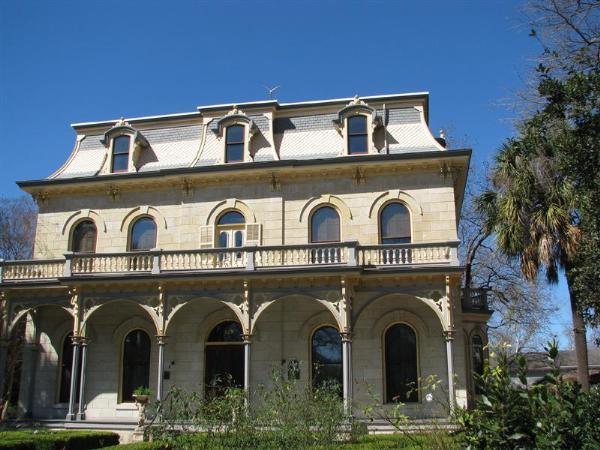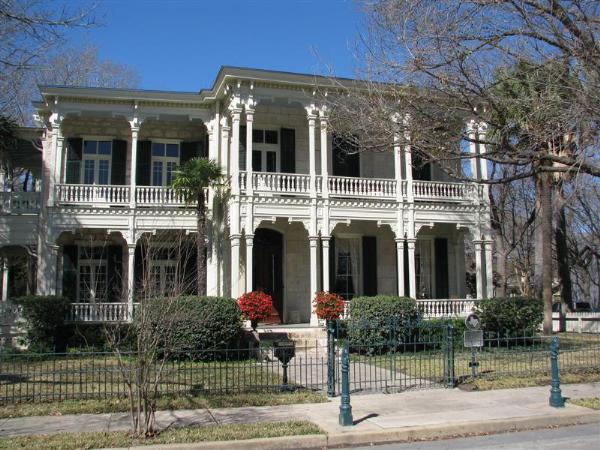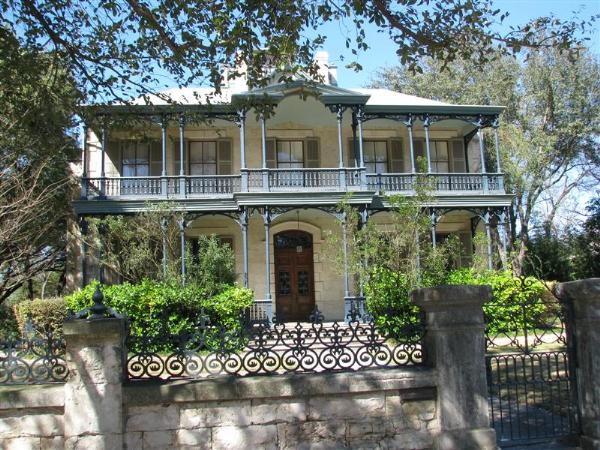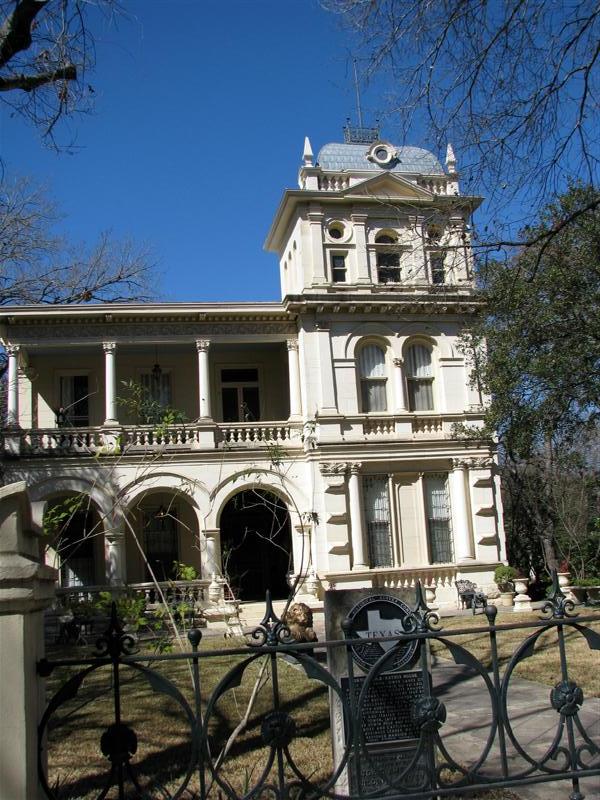|
The King William Historic District is a tree-shaded neighborhood of Victorian
and turn-of-the-century homes, close to downtown San Antonio. The highest
concentration of architecturally significant residence occurs along both sides
of King William Street. 0f the fifty structures on this five-block-long street,
forty-three contribute to the nineteenth-century character of the district.
Several buildings are particularly outstanding. The Wulf House, an 1873 pink
stucco Italian Villa, is the principal north terminus for the district. Across
from it is a stuccoed one- story house with wide inset front porch, typical of
the vernacular building style of this region in the middle of the nineteenth
century. The one-story Sartor House is an excellent example of a Victorian house
that appears frequently in San Antonio. The Ike West House is a Victorian
two-story home with a confection of iron cresting along the varying levels of
its roof and turned balusters and spindles on its curved porches.
Three mansions on King William Street would be architecturally significant
even isolated from the district: the eclectic Renaissance derived Polk Mansion;
the Groos House, 1880, with elaborate Victorian tracery on its galleries and an
Italianate cupola; and the Steves Homestead, 1876, another eclectic mix with
French Renaissance touches on a sturdy symmetrical two-story house.
Guenther Street, and the San Antonio River behind it, form the south
boundary of the district. Across the river are the tall buildings of the Pioneer
Flour Mills, on the site of the original 1859 mill. Madison and City Streets run
parallel to King William Street. The houses on these streets are individually
less important, but add substantially to the quality of the area.
There are three fine houses on the one-block-long Washington Street. The
most important of these is the Newton Mitchell or Oge House, an imposing
two-story late Greek Revival residence built for the Commanding Officer's
Quarters for the nearby San Antonio Arsenal in 1860.
Large trees, generous lawns, picket and iron fences frame the rows of
Victorian houses and mansions of the King William Historic District. The area
was primarily established by prosperous German businessmen in the second half of
the nineteenth century. The district is only a few blocks south of the simple,
vernacular La Villita Historic District and downtown San Antonio. In contrast,
the King William homes are opulent Victorian buildings with Italianate towers,
mansard roofs, or fancy scrollwork.
The lands now occupied by the King William Historic District are on the
meandering San Antonio River and were once an irrigated farm belonging to
Mission Concepcion. When the missions were secularized, the land passed to Pedro
Huizar, Vincent Amador, and Juana Fuentes, and then was purchased in the 1840s
by Thomas Jefferson Devine, a San Antonio lawyer and land speculator. Devine
sold most of the northern section to Catherine Elder who transferred it to her
husband, Newton Mitchell, when she married in 1857. Devine and Mitchell
subdivided their properties into lots. Carl Guenther, a German miller, had
purchased the southwestern section of the area, in 1859, and established a mill
and his home there. These have been modernized and have grown, but still form
the terminus of the King William District. (Taylor and Taylor. "The King William
Neighborhood: An Appraisal." pp. 2-3.)
"(The King William District) prospered as Germans who had come to Texas in
the great Auswanderung of the 1840s ... (and subsequently enriched themselves),
followed Carl Guenther and his mill into what the rest of San Antonio began to
call 'Sauerkraut Bend.' In 1873 Anton Frederick Wulf, a merchant and alderman
built an Italianate villa at the head of King William Street. During the 1880s
the street acquired an unmistakable air of burgerlich respectability, as Robert
Hansche, the editor of the Freie Presse Fuer Texas; Karl Willem Groos, merchant
and banker; Eduard Steves, lumberman; Edward Steves, Jr., firearms merchant;
Carl Harnisch, confectioner; August Beisenbach, hardware merchant; Ernst Altgelt,
land agent; and Charles Hummel all built imposing homes along it." (Taylor and
Taylor. "The King William Neighborhood: An Appraisal." p.4)
Although all of the above were of German stock, not all King William
residents were German. At the head of Washington Street the United States had
built a fine two- story late Greek Revival residence as Commanding Officer's
quarters for the San Antonio Arsenal nearby. This house is now known as the
Newton Mitchell House or the Oge House, for the families that later owned the
building. The Oge House, and the Norton Polk House, the Steves Homestead, the
West House, Wulff House and Groos House on King William Street are the most
outstanding residences in the district.
Madison Street was developed primarily in the 1890s although there are a
few earlier buildings there also. Together with City Street, on the opposite
bank of the San Antonio River from King William Street, it has somewhat less
distinguished architecture than that on King William Street itself, but are one
with the neighborhood in Victorian mood and provide a buffer for the core of the
district.
In the early twentieth century suburban areas of San Antonio began to
replace the King William District as choice residential areas, and by the 1930s
and `40s the average number of tenants per house had greatly increased and there
had been a general decline in the prestige of the neighborhood. Some of the
homes continued to be occupied by the original families, however, and by the
late sixties restoration had begun to revive the attractiveness of the area.
~
Texas Historical Commission Atlas
|

Steves House

Cabot House

Oge House

Groos House

Norton-Polk-Mathis House |